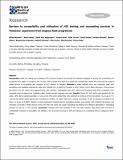| dc.contributor.author | Meremo, Alfred | |
| dc.contributor.author | Mboya, Beati | |
| dc.contributor.author | Ngilangwa, David | |
| dc.contributor.author | Dulle, Robert | |
| dc.contributor.author | Tarimo, Edith | |
| dc.contributor.author | Urassa, David | |
| dc.contributor.author | Michael, Emillian | |
| dc.contributor.author | Gibore, Nyasiro | |
| dc.contributor.author | Mpondo, Bonaventura | |
| dc.contributor.author | Mchonde, Gabriel | |
| dc.contributor.author | Ernest, Alex | |
| dc.contributor.author | Noronha, Rita | |
| dc.contributor.author | Ilako, Festus | |
| dc.date.accessioned | 2021-08-25T19:46:23Z | |
| dc.date.available | 2021-08-25T19:46:23Z | |
| dc.date.issued | 4/14/2016 | |
| dc.identifier.citation | Alfred Meremo et al. Barriers to accessibility and utilization of HIV testing and counseling services in Tanzania: experience from Angaza Zaidi programme. Pan African Medical Journal. 2016;23:189. [doi: 10.11604/pamj.2016.23.189.5683] | en_US |
| dc.identifier.issn | 1937-8688 | |
| dc.identifier.uri | http://repository.amref.org/handle/123456789/145 | |
| dc.description | © Alfred Meremo et al. The Pan African Medical Journal - ISSN 1937-8688. This is an Open Access article distributed under the terms of the Creative Commons
Attribution License (http://creativecommons.org/licenses/by/2.0), which permits unrestricted use, distribution, and reproduction in any medium, provided the original
work is properly cited. | en_US |
| dc.description.abstract | Introduction: While HIV testing and counseling (HTC) services remain to be amongst the effective strategies in slowing HIV transmission, its
accessibility and uptake in Tanzania is low. In 2011, 50% of adults have been ever tested and received their results. We conducted this study to
assess barriers to accessibility and utilization of HTC services in Tanzania. Methods: A mixed methods study was conducted using both
quantitative and qualitative approaches. Data were collected in in 9 regions of Tanzania in 2012. Twelve (12) in-depth interviews, 8 Focus Group
Discussions and 422 clients were approached for data collection. Quantitative data were entered and analysed using SPSS, proportions were
compared using chi-square test. Qualitative data, content analysis approach was used. Results: Overall 422 exit clients were enrolled into the
study, 4.9% clients reported spending >2 hours at the HTC centre before they were attended (p<0.0001). Of the 422 clients in our study 5.7 %
received HIV testing before getting HIV counseling (p=0.0001). Of those clients who received counseling, 21.8% of reported counseling to be
done in a group (p=0.0001). Majority of study participants reported that the counselling sessions were private, with sufficient information, and
interactive (p<0.0001). Mobile services clinics, the Post Test Clubs and couple counselling and testing were effective approaches in stimulating
demand for and use of HTC services. Conclusion: Findings show that coverage of HTC was high, however long waiting time and lack of
confidentiality impeded its accessibility and utilization. We recommend increase of staff and adherence to counselling ethics to safeguard clients'
privacy. | en_US |
| dc.language.iso | en | en_US |
| dc.publisher | Pan African Medical Journal | en_US |
| dc.subject | Barriers | en_US |
| dc.subject | HIV testing | en_US |
| dc.subject | Counseling | en_US |
| dc.subject | Tanzania | en_US |
| dc.title | Barriers to Accessibility and Utilization of HIV Testing and Counseling Services in Tanzania: Experience from Angaza Zaidi Programme | en_US |
| dc.type | Article, Journal | en_US |

